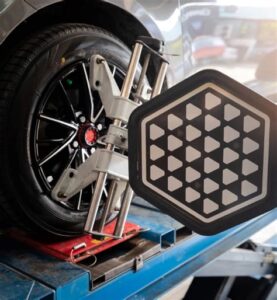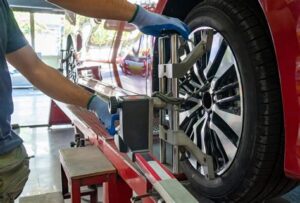Discover the importance of car alignment, signs of misalignment, its effects on tires, and how to check or seek professional alignment services.Is your car pulling to one side, or are your tires wearing unevenly? These could be signs that your vehicle is out of alignment, a common issue that can affect your driving experience and safety. Understanding car alignment is vital for optimal performance and longevity of your tires. In this blog post, we’ll explore the key signs of misalignment, the potential impacts on your tires, and how to conduct a DIY alignment check. While some alignment issues can be addressed at home, we’ll also discuss when it’s best to seek professional alignment services. Whether you’re a seasoned driver or a new car owner, this guide will help you keep your vehicle in top condition and ensure a smooth, safe ride. Let’s dive in!
Understanding Car Alignment
Car alignment refers to the adjustment of a vehicle’s suspension system, ensuring that the wheels are set to the optimal position relative to each other and the road. Proper alignment is crucial for vehicle handling, tire life, and fuel efficiency. When aligned correctly, the car will navigate straight without requiring constant steering corrections.
There are three primary angles that are adjusted during the alignment process: camber, caster, and toe. The camber angle is the tilt of the wheel in relation to the vertical axis when viewed from the front; it affects tire wear. The caster angle is the angle of the steering axis in relation to the vertical axis when viewed from the side; it affects the stability of the vehicle. Lastly, the toe angle measures the direction the wheels point in relation to the centerline of the vehicle.
Neglecting proper alignment can lead to uneven tire wear and decreased handling performance, resulting in a less safe driving experience. Regular checks are recommended, especially after hitting potholes or curbs, or if a change in driving behavior occurs.
Signs of Misalignment
One of the most prevalent issues many drivers encounter is misalignment. Not only can it affect the handling of your vehicle, but it can also cause premature wear and tear on your tires. Understanding the signs of misalignment will help you address the issue promptly and avoid more serious problems.
Here are some common signs of misalignment to watch out for:
- Uneven tire wear: If you notice that the tread on your tires is wearing down unevenly, it’s a strong indicator that your car may be out of alignment.
- Pulling to one side: If your car pulls to the left or right while driving on a flat surface, this can signal an issue with alignment.
- Steering wheel off-center: A steering wheel that is not centered when driving straight can also indicate that your vehicle is misaligned.
- Vibration in the steering wheel: If you feel a constant vibration in the steering wheel while driving, it can point towards misalignment.
Being vigilant about these signs can save you from potential accidents and costly repairs. If you notice any of these indicators in your vehicle, i
Effects of Misalignment on Tires
When it comes to the health of your vehicle, one critical factor often overlooked is tire alignment. Misalignment can lead to a plethora of negative consequences that not only affect the performance of your car but also the longevity of your tires. Understanding the effects of misalignment can save you both time and money in the long run.
One of the most noticeable effects of misalignment is uneven tire wear. When your wheels are not aligned correctly, some tires will bear more weight than others, leading to rapid wear in specific areas. For instance, you may start to notice that the edges of your tires wear down faster compared to the center. This not only shortens the life of your tires but also requires more frequent replacements, impacting your overall vehicle maintenance costs.
Additionally, misaligned wheels can cause handling issues. When you drive, you might find that your car pulls to one side, which can make for a dangerous driving experience, especially at high speeds. This uneven handling can lead to poor traction, particularly in wet or slippery conditions. To summarize, the effects of misalignment on tires include:
- Uneven tire wear
- Increased fuel consumption
- Poor vehicle handling
- Reduced tire lifespan
Ignoring these signs of misalignment not only puts your tires at risk but can also compromise your safety on the road. Regularly checking and maintaining your car’s alignment is essential for an optimal driving experience.
DIY Alignment Check
Performing a DIY alignment check on your vehicle can save you time and money while ensuring your car drives smoothly. One of the easiest ways to determine if your car is out of alignment is through simple visual and physical inspections. Here are some common methods you can use:
- Tire Wear Patterns: Inspect your tires for uneven wear. If your tires show signs of excessive wear on the inner or outer edges, it may indicate a misalignment.
- Steering Wheel Position: When driving on a straight and level road, your steering wheel should be centered. If it is off to one side, this may signal an alignment issue.
- Vehicle Pulling: Pay attention to how your car handles. If it pulls to one side when you let go of the steering wheel, it’s a clear sign of misalignment.
For a more thorough check, you can also perform a string alignment test:
- Find a level surface to park your car and ensure it is straight.
- Get a long piece of string or a measuring tape and tie it to the front and rear axles.
- Measure the distance from the string to the edges of the tires on both sides. If the measurements differ significantly, your car may be out of alignment.
Although a DIY alignment check can reveal potential issues, it is essential to seek professional assistance if you suspect that your car is misaligned. Proper alignment tools and techniques are vital for ensuring precise adjustments.
Professional Alignment Services
When it comes to maintaining your vehicle’s performance, seeking professional alignment services is essential. Unlike a casual DIY check, professional services ensure that your car receives a meticulous evaluation using advanced equipment and techniques. Certified technicians are trained to identify even the most subtle misalignments, providing you with peace of mind and a safer driving experience.
During a professional alignment service, technicians will typically perform a thorough inspection of your vehicle’s suspension components and adjust the angles of the wheels according to the manufacturer’s specifications. This process typically involves the following steps:
- Visual inspection of tires for uneven wear
- Measuring the current alignment angles
- Adjusting the camber, caster, and toe as needed
- Road test to ensure proper performance
One of the biggest advantages of opting for professional alignment services is the use of state-of-the-art machinery that provides precise measurements. This precision helps in prolonging the lifespan of your tires, enhancing fuel efficiency, and ensuring that your vehicle handles safely and predictably on the road. If you notice signs of misalignment such as your vehicle pulling to one side
Frequently Asked Questions
What are the common signs that indicate a car is out of alignment?
Common signs include uneven tire wear, the steering wheel being off-center, pulling to one side while driving, and a vibration in the steering wheel.
How can I tell if my tires are wearing unevenly due to alignment issues?
Look for tread wear patterns such as bald spots on one side of the tire, or more wear on the inside or outside edges compared to the center.
Is it safe to drive a car that is out of alignment?
While you can drive a misaligned car, it can pose safety risks by impairing your handling and response times, and may lead to further damage or an accident.
How often should I check my car’s alignment?
It’s advisable to check your car’s alignment every 6,000 to 10,000 miles or whenever you replace tires, hit a large pothole, or notice changes in handling.
What steps should I take if I suspect my car is out of alignment?
If you suspect misalignment, you should perform a visual inspection of the tires, check the steering response, and visit a professional mechanic for a complete alignment check.
Can an alignment issue affect fuel efficiency?
Yes, misalignment can cause your vehicle to work harder and consume more fuel, which reduces overall fuel efficiency.
What is the cost range for a car alignment service?
The cost for a car alignment typically ranges from $75 to $100, but it can vary depending on the make and model of the vehicle, as well as additional services required.





